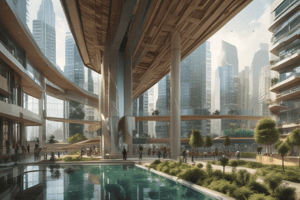Podcast
Questions and Answers
What is the primary goal of sustainable architecture?
What is the primary goal of sustainable architecture?
- To maximize the use of materials
- To prioritize the use of fossil fuels
- To increase the size of buildings
- To minimize the negative environmental impact of buildings (correct)
What is the difference between passive and active techniques in sustainable architecture?
What is the difference between passive and active techniques in sustainable architecture?
- Passive techniques are only used in temperate climates
- Passive techniques conserve energy while active techniques generate energy (correct)
- Passive techniques generate energy while active techniques conserve energy
- Passive techniques are more powerful than active techniques
Which renewable energy sources are commonly used in sustainable architecture?
Which renewable energy sources are commonly used in sustainable architecture?
- Coal and natural gas
- Hydroelectric and nuclear
- Solar panels and wind turbines (correct)
- Geothermal and biomass
What is the most efficient use of air source heat pumps?
What is the most efficient use of air source heat pumps?
What is the advantage of using ground-source heat pumps over air-source heat pumps?
What is the advantage of using ground-source heat pumps over air-source heat pumps?
What is BIM in sustainable architecture?
What is BIM in sustainable architecture?
What is the focus of waste management in sustainable architecture?
What is the focus of waste management in sustainable architecture?
What is the role of sustainable building consultants in the design process?
What is the role of sustainable building consultants in the design process?
What is the purpose of green roofs in sustainable architecture?
What is the purpose of green roofs in sustainable architecture?
Flashcards
Sustainable Architecture
Sustainable Architecture
An approach minimizing the negative environmental impact of buildings through efficient use of resources.
Site Analysis in Architecture
Site Analysis in Architecture
Analyzing a site to maximize the use of natural resources like sunlight and wind for heating and ventilation.
Renewable Energy Use
Renewable Energy Use
Using resources like solar panels and wind turbines to reduce reliance on fossil fuels.
Efficient HVAC Strategies
Efficient HVAC Strategies
Signup and view all the flashcards
Passive Daytime Radiative Cooling
Passive Daytime Radiative Cooling
Signup and view all the flashcards
Sustainable Building Materials
Sustainable Building Materials
Signup and view all the flashcards
Building Information Modeling (BIM)
Building Information Modeling (BIM)
Signup and view all the flashcards
Sustainable Building Placement
Sustainable Building Placement
Signup and view all the flashcards
Water Usage Conservation
Water Usage Conservation
Signup and view all the flashcards
Study Notes
Sustainable architecture is an approach that aims to minimize the negative environmental impact of buildings. This is achieved through efficient use of materials, energy, development space and the ecosystem at large. The approach involves a conscious approach to energy and ecological conservation in the design of the built environment. Sustainable architecture is positioned within a much broader cultural framework of the human interrelationship with nature. The use of passive and active techniques to reduce the energy needs of buildings and increase their ability to capture or generate their own energy is a priority in sustainable architecture. Site analysis is employed to optimize use of local environmental resources such as daylight and ambient wind for heating and ventilation. Renewable energy sources such as solar panels, wind turbines, solar water heating and heat pumps are used to supplement fossil fuel resources. The efficiency of wind turbines depends on wind conditions at the building site. Active solar water systems are more powerful than passive systems. Air source heat pumps are most efficiently used in temperate climates. Exhaust air heat pumps can recover around 2-3 times more energy than an air-to-air exchange system.Sustainable Building Design
- Efficient HVAC strategies include air-source and ground-source heat pumps, as well as exhaust air heat pumps (EAHP).
- Ground-source heat pumps are more efficient than air-source heat pumps and can be 40% to 60% more efficient than air-source counterparts.
- Passive daytime radiative cooling harvests the coldness of outer space as a renewable energy source to achieve daytime cooling.
- Sustainable building materials include recycled denim, hempcrete, bamboo, and locally obtained stone and rock.
- Recycled or second-hand materials are often used in sustainable architecture to reduce embodied energy.
- Low-impact building materials are used wherever feasible, and organic or milk-based paints may be used.
- Lab-grown organic materials are being developed in place of traditionally harvested materials.
- Building information modeling (BIM) is used to help enable sustainable design.
- Sustainable building consultants may be engaged early in the design process to forecast the sustainability implications of building materials.
- Building placement is a central aspect of sustainable architecture, and building location should be chosen to avoid suburban sprawl.
- Water usage in sustainable buildings is conserved through green roofs and wastewater treatment.
- Sustainable urbanism takes actions beyond sustainable architecture to make a broader view for sustainability.
- Waste management in sustainable architecture focuses on the on-site use of waste management, incorporating things such as grey water systems and composting toilets.
Studying That Suits You
Use AI to generate personalized quizzes and flashcards to suit your learning preferences.





